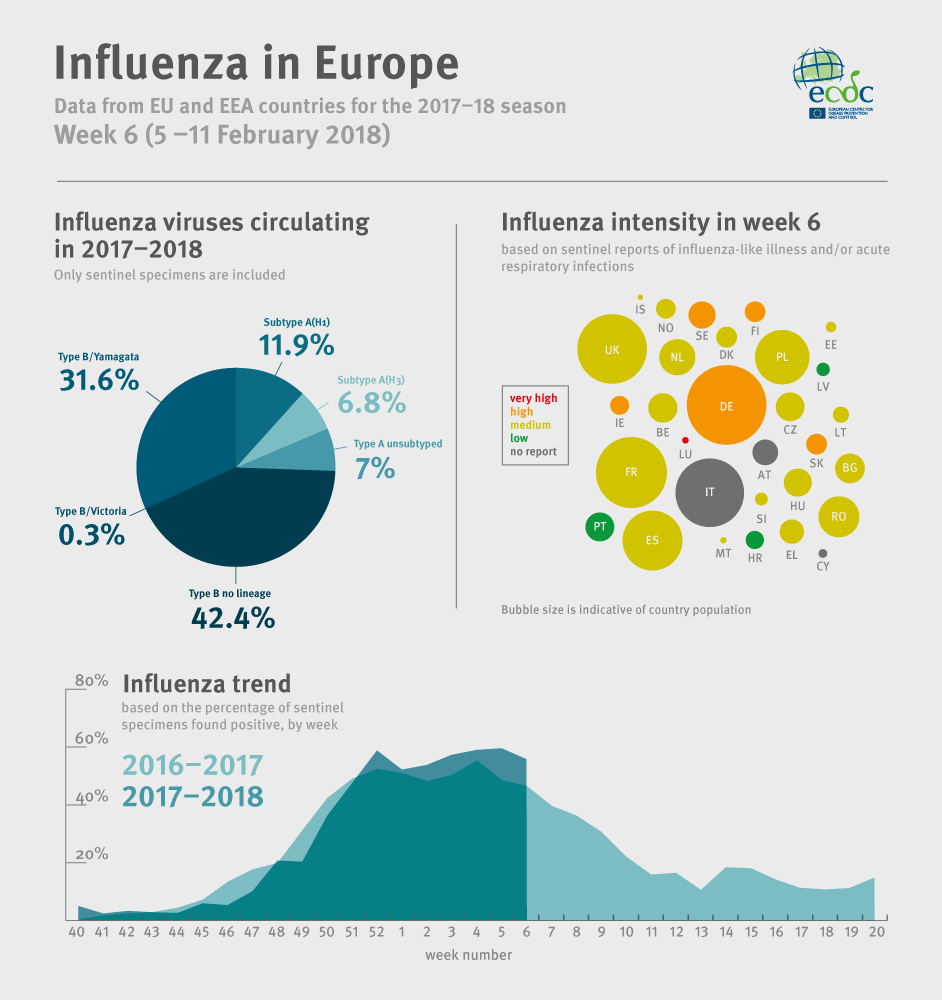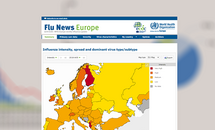Weekly influenza update, week 6, February 2018
Influenza activity was widespread in the majority of reporting countries. Both influenza virus types A and B were co-circulating with a higher proportion of type B viruses. Different proportions of circulating influenza virus types and A subtypes were observed between countries. Of the individuals sampled, on presenting with ILI or ARI to sentinel primary healthcare sites, 51% tested positive for influenza viruses. The detection rate decreased compared to the previous week (55%).

Download

Flu News Europe, week 6/2018
- EN - [PNG-96.64 KB]
The material herein is provided in a format for easy adaptation. See our Legal notice
Summary
- Influenza activity was widespread in the majority of reporting countries.
- Both influenza virus types A and B were co-circulating with a higher proportion of type B viruses. Different proportions of circulating influenza virus types and A subtypes were observed between countries.
- Of the individuals sampled, on presenting with ILI or ARI to sentinel primary healthcare sites, 51% tested positive for influenza viruses. The detection rate decreased compared to the previous week (55%).
- The majority of severe cases reported this season are due to influenza B and occur in persons above the age of 15 years. In confirmed influenza cases in ICU, similar numbers of cases were infected with influenza A or influenza B. In laboratory confirmed cases reported in wards other than ICU, influenza B was detected approximately twice as frequently as influenza A and mainly in the >65 age group
- WHO is convening the Vaccine Composition Meeting on 19–21 February to decide on the composition of the 2018–2019 Northern hemisphere vaccine.
2017/18 season overview
- For the Region overall, a higher proportion of type B compared to type A viruses has been detected in sentinel and non-sentinel sources. Of the type A detections from sentinel sources, A(H1N1)pdm09 viruses have outnumbered A(H3N2) viruses, while in non-sentinel sources more A(H3N2) viruses were reported than A(H1N1)pdm09 viruses.
- The majority of severe cases reported this season are due to influenza B and occur in persons above the age of 15 years. In confirmed influenza cases in ICU, similar numbers of cases were infected with influenza A or influenza B and approximately equal numbers of cases were reported in the 15–64 and >64 age groups. In laboratory confirmed cases reported in wards other than ICU, influenza B was detected approximately twice as frequently as influenza A and twice as many cases occurred among those >64 compared with patients in the 15–64 age group.
- For type B viruses from both sentinel and non-sentinel sources, B/Yamagata lineage viruses have greatly outnumbered those of the B/Victoria lineage. The current trivalent seasonal influenza vaccine does not include a virus from the B/Yamagata lineage.
- Different patterns of dominant type and A subtype were observed between the countries in the Region, which may be due to differences in relative weights of information being derived from sentinel, non-sentinel and severe influenza case sources of information between countries.
- While low in number, 59% of the genetically characterized A(H3N2) viruses belong to clade 3C.2a, the clade of the vaccine virus described in the WHO recommendations for vaccine composition for the northern hemisphere 2017–2018, and 37% to subclade 3C.2a1, with mammalian cell-cultured viruses in both clades being antigenically similar.
- A situation analysis that describes the early season evolving epidemiological pattern was published by WHO Regional Office for Europe in January. A high level of influenza B virus circulation was observed during the first half of the season, compared to previous seasons.
- An early risk assessment based on data from EU/EEA countries was published by ECDC on 20 December 2017.
- Interim or real-time vaccine effectiveness estimates from Canada, Finland, Germany, Spain, Stockholm County and the United States of America suggest overall vaccine effectiveness of 15–46%, depending on the proportion of circulating (sub)types. Effectiveness against influenza B is in the range of 35–67%, despite the circulating lineage not being included in the more commonly used trivalent vaccine.
- European mortality among the elderly has significantly increased over the past weeks in the western parts of Europe.
- Additional information on global influenza activity is available from WHO’s biweekly global updates.






